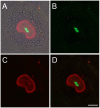R26R-GR: a Cre-activable dual fluorescent protein reporter mouse
- PMID: 23049968
- PMCID: PMC3458011
- DOI: 10.1371/journal.pone.0046171
R26R-GR: a Cre-activable dual fluorescent protein reporter mouse
Abstract
Green fluorescent protein (GFP) and its derivatives are the most widely used molecular reporters for live cell imagining. The development of organelle-specific fusion fluorescent proteins improves the labeling resolution to a higher level. Here we generate a R26 dual fluorescent protein reporter mouse, activated by Cre-mediated DNA recombination, labeling target cells with a chromatin-specific enhanced green fluorescence protein (EGFP) and a plasma membrane-anchored monomeric cherry fluorescent protein (mCherry). This dual labeling allows the visualization of mitotic events, cell shapes and intracellular vesicle behaviors. We expect this reporter mouse to have a wide application in developmental biology studies, transplantation experiments as well as cancer/stem cell lineage tracing.
Conflict of interest statement
Figures







References
-
- Chalfie M, Tu Y, Euskirchen G, Ward WW, Prasher DC (1994) Green fluorescent protein as a marker for gene expression. Science 263: 802–805. - PubMed
-
- Shimomura O, Johnson FH, Saiga Y (1962) Extraction, purification and properties of aequorin, a bioluminescent protein from the luminous hydromedusan, Aequorea. J Cell Comp Physiol 59: 223–239. - PubMed
-
- Misgeld T, Kerschensteiner M, Bareyre FM, Burgess RW, Lichtman JW (2007) Imaging axonal transport of mitochondria in vivo. Nat Methods 4: 559–561. - PubMed
-
- Shaner NC, Campbell RE, Steinbach PA, Giepmans BN, Palmer AE, et al. (2004) Improved monomeric red, orange and yellow fluorescent proteins derived from Discosoma sp. red fluorescent protein. Nat Biotechnol 22: 1567–1572. - PubMed
Publication types
MeSH terms
Substances
Grants and funding
LinkOut - more resources
Full Text Sources
Medical
Molecular Biology Databases
Research Materials

